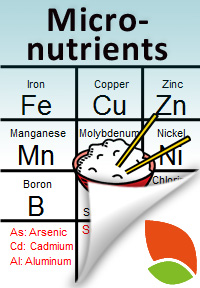The latest Teaching Tool in Plant Biology explores the theme of “Micronutrients and Metals”. By definition, the micronutrients (Fe, Cu, Zn, Mn, Mo, Ni, B, Si and Cl) are essential for plant life, and most are also essential for human and other animal life. About a quarter of cellular proteins are metalloproteins that associate tightly with a metal. The foundation of cellular energetics, the electron-transport chains in mitochondria and chloroplasts, rely on the redox potentials of iron- and copper-binding proteins. Other metals contribute to protein structure, such as in the zinc-finger domains that stabilize ribosomes and transcription factors.
More than just fascinating chemistry, the topic of micronutrients also encompasses two significant human health concerns. Globally more than two billion people suffer from a deficiency of iron, zinc or both. Efforts to alleviate this condition include agronomic and cultural practices alongside classical and biotechnology-enhanced breeding strategies. The toxic elements arsenic and cadmium are listed by the World Health Organization among their “top ten chemicals of major public health concern”. It is not trivial to prevent plants from accumulating these toxic elements as they move into plant tissues through the same mechanisms that are used by essential nutrients, but several lines of research show promising results.
Finally, metal hyperaccumulating plants and the strategies they employ are examined. Insights from these plants have applications in phytoremediation and phytomining efforts as well as micronutrient biofortification strategies.
Teachers take note that the Teaching Guide is full of ideas for in- or out-of-class study, discussion and engagement activities. Whether you’re teaching, learning or just trying to keep up with current research, you’ll find something to capture your imagination here. And maybe, like me, you’ll find a greater appreciation for the importance of bioinorganic chemistry in plant science and the world around us.
